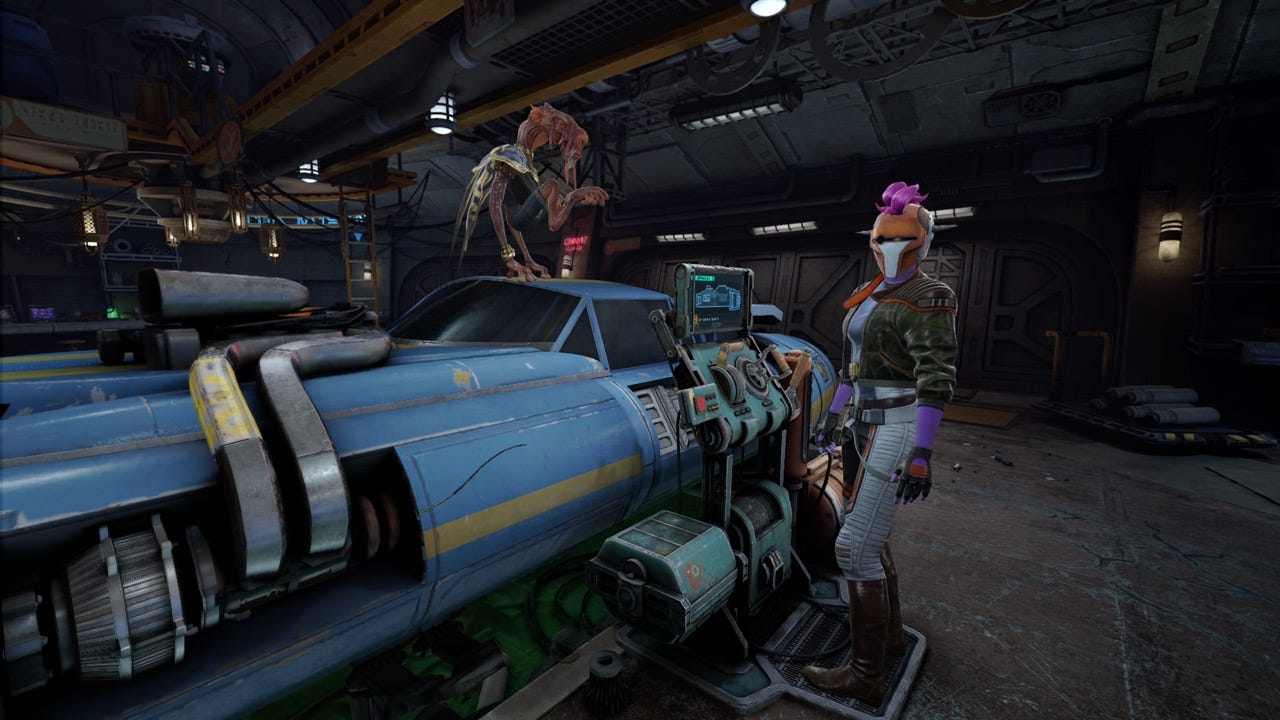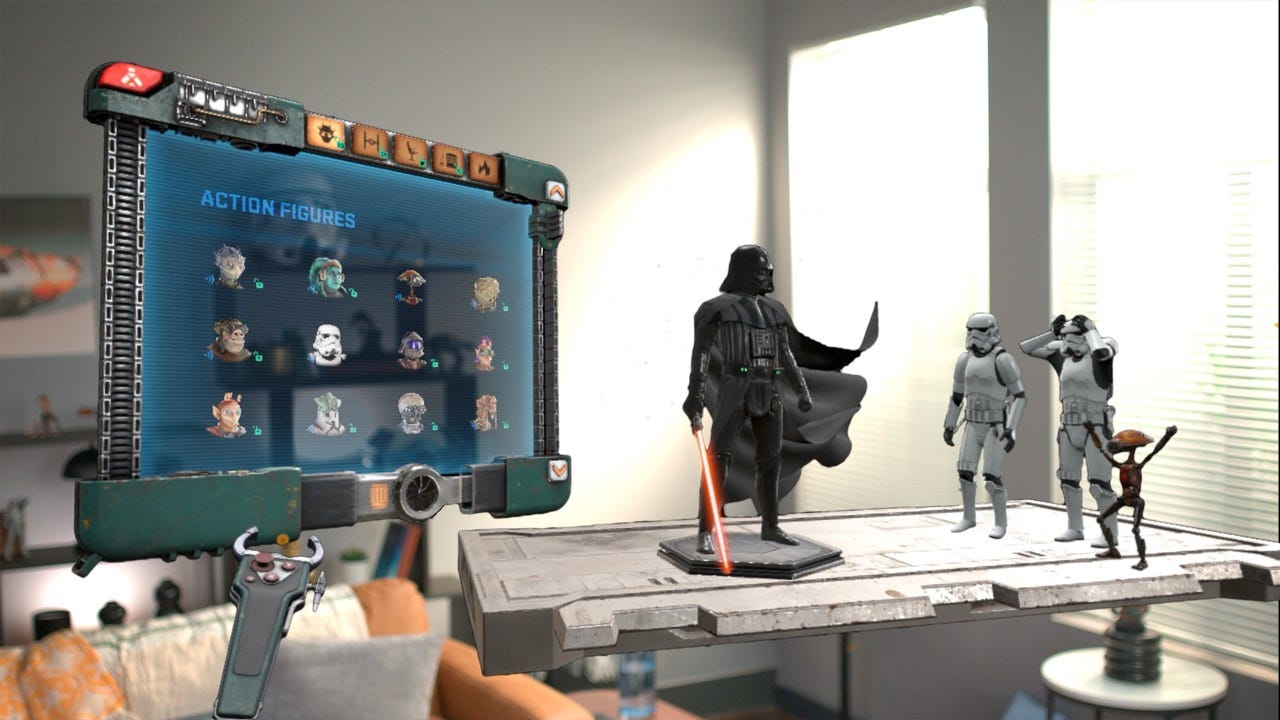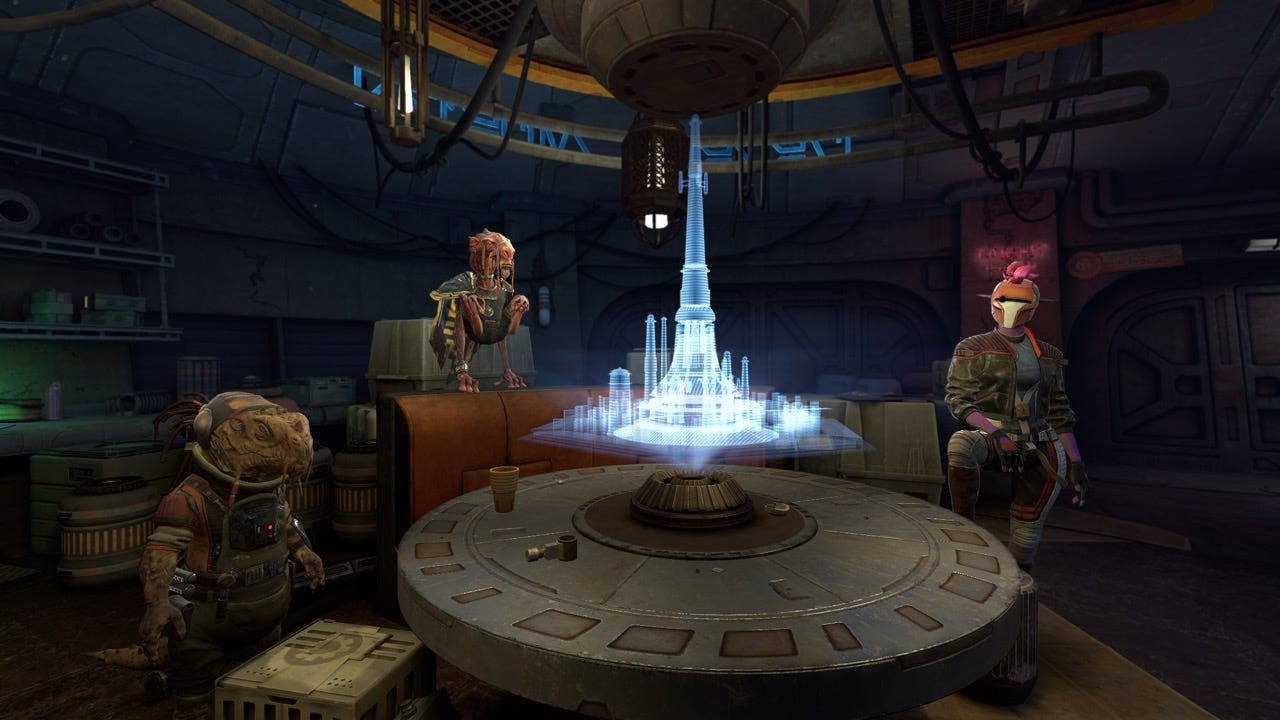Racing ‘Beyond Victory’ With The Latest Immersive Star Wars Game From ILM (Preview)
‘Star Wars: Beyond Victory — A Mixed Reality Playset’ launches Oct. 7th


The helmeted human, at least I think she’s human, makes her way into my garage with a lot of attitude but not an ounce of it can come close to the diminutive Dug who pads into the place like he owns it after her.
Sebulba.
The greatest podracer who ever tossed a wrench into a competitor’s engine. In my garage. Looking to get back in the game.
Of course, I’m not in my garage. Today I’m not even in my living room. I’m in a cleverly named meeting room somewhere on the west side of LA where members of the team behind Star Wars: Beyond Victory — A Mixed Reality Playset, launching on October 7th, 2025 exclusively for Meta
Quest 3 & 3S headsets, are watching me go through the story demo of their latest creation.
Over the next hour I’ll have a chance to embody the game’s lead character, the up an coming podracer Volo Bolus, race his pod in an arcade-style game that makes use of mixed reality mode on Meta’s Quest 3 headset, and play with a virtual action figure of Volo and more. That, and talk with Industrial Light & Magic’s Harvey Whitney and David RS Palumbo in a far ranging conversation about the state of the art in mixed reality and bringing some deep cut Star Wars lore elements to life, all for just for $19.99 at launch.
Indeed Beyond Victory is dubbed “A Mixed Reality Playset” by the team, and it’s that approach which intrigues here, as theres a lot going on under the hood, with more than can be obvious from half hour of playtime and about the same amount of chatting, but which the extensive menus of the “Playset” mode itself hint at.
We’ll get there. First: what the heck is Star Wars: Beyond Victory: A Mixed Reality Playset?
That was the question that arose when the first word of the game hit at Star Wars Celebration this past April. There was footage of the podracing part of the game, which took place via a Mixed Reality interface, and an exclusive comic book that was released which sets the story firmly during the Reign of the Empire era Star Wars. Exactly what we’d be doing, how much was going to be podracing, and what a playset had to do with it all was up for grabs.
The main story plays out across a mix of modes.
The first are the familiar first-person VR sequences of Vader Immortal and Tales from the Galaxy’s Edge: fully built out, interactive environments with fleshed out characters put you into the “cut scenes” of the game so that you feel like you’re in Star Wars. Well, at least for what I saw of it. There’s enough mechanical fidelity in the toolset that ILM has at their disposal that there might be more to these sequences, with the trailer hinting at some interactive sequences to come.
The second mode uses the “holotable,” a floating, resizable and movable platform which the user has control over, to act out scenes at various scales. The holotable is also where the podraces, both for the story and arcade modes, are played. Adjusting the table and moving it about is intuitive. When the scene shifts to a birds-eye view of the action, it’s a bit like watching action figures play out a Star Wars story. Which is, one realizes over time, the point. Some of that illusion is shaken up when the scene “cuts” to focus on two characters having a chat, breaking the unity of the scene. It makes me wish that they had either left that as an option or kept the cuts out entirely. Maybe I’ll get used to it in time. Still: there’s something perfect about watching “the toys come to life.”

This being a podracing game there are two engines on Beyond Victory, the first being the podracing itself. Judging from my first run at it, I once again suck at podracing.
Get Noah J Nelson’s stories in your inbox
Join Medium for free to get updates from this writer.
SubscribeSubscribe
Star Wars Episode I: Racer held the record for best selling sci-fi racing game for a very long time, which makes the act of playing a podracing videogame as iconic as the sequence from the movie itself. The initial teaser, and to some degree the current trailer, don’t do the podracing in the actual game justice as its hard to convey how well the holotable works. It’s one thing to look at a flat video of the table in situ being projected into a living space, which suggests that the table is just this tiny slice and you’re going to get distracted by all the stuff that’s around you. It’s quite another to be standing next to the table, leaning over it, and cursing in Huttese as that globular thing in the middle of the track takes your pod out again because you haven’t figured out which button is the boost button yet.
In short: there’s more than enough visual information to focus on once you start playing, and the table can be stretched out to a pretty good size. It’s one of those things that remains tricky about immersive media as a whole: the experience really doesn’t translate well into other visual mediums. (Hopefully I’ve done my job here with text to convey the experience.)
The podracing itself? Well, that feels like podracing, and while I only had time with the one track we were definitely right back into the Racer paradigm of a kind of malicious Mario Kart when it comes to track design with the alien landscape aesthetics of Star Wars. Anyone who spent time with the original game, and pretty much a whole generation did, will get some nostalgia pangs. (Sometimes I think that game might have as much to do with the revival popularity of the prequels as The Clone Wars animated series did.) Arcade mode for the game will let players run the various tracks outside of story mode, which hopefully also means I can practice without embarrassing myself inside story mode when I go for a deep role play run.
Play is the real operative word when we get to the most fascinating mode, Playset, from which Beyond Victory takes part of its name.

Before I’m unleashed on the mode, Experience Design Lead David RS Palumbo, starts a walkthrough for me, a previous play session having been left set up in the room. I watch this cast from the Quest headset to the TV that’s in the room, which along with videos made by users will be the way that folks can share the experience with others — Beyond Victory is a single player game — and see that full scale droids have been left behind from last time.
Palumbo does some cleanup and then scrolls through the Playset menus to one marked “Action Figures” before I can ask “how many points of articulation do they have” like the Star Wars Black Series collector that I am Palumbo is demonstrating just how many. The answer is: a lot. The figures can be posed nearly as intricately as a clay maquette, and accessories snap into their hands. Pick a blaster, like the iconic Bryer blaster pistol from Dark Forces and Andor, and give it to a character and now that character can shoot blaster bolts. And those blaster bolts can blow up things.
It’s an extension of play, two steps out from what the toys themselves can do.
The elements in the toybox can be scaled up and down. At one point I try and get the figure for Grakkus the Hutt, a muscular crime lord first introduced in the comics who plays a part in Beyond Victory’s story, to 100% and giddly give up a third of a way through the process once he’s already clipping out of the walls. Grakkus will have to wait for my parking lot. Vehicles can be scaled down: I watch Palumbo use scenery to create what is essentially a Hot Wheels track to run podracers on. I myself ram an Imperial speeder into the room’s couch and it explodes satisfactorily. The game taps into Meta’s spatial info to create the mixed reality layer so that objects in your space are also in the virtual space. This makes for more realistic interactions, although the spatial tech does tend to deal in absolutes: I had scaled that speeder down small enough that it could have slipped under the couch, but for the headset “couch” is a hard border.

In my conversation with Palumbo and Whitney some of the origin of Beyond Victory as emerging from the VR toolsets used by filmmakers being translated into a toybox is revealed. The aim here, as the twenty dollar price point makes clear, isn’t to offer up a machinima set, although the team is looking forward to seeing the dioramas that people make. The goal is to offer up toys, glorious toys, with a degree of fidelity that hasn’t really been seen in VR & MR yet.
Given my time with the game, the broad user base of the Quest, and the price point they’ve set for the release, this feels like a properly dialed in choice, and a good jumping on point for those who haven’t checked out ILM’s previous immersive game offerings, which remain standard bearers for what narrative centered immersive gaming can be.
Star Wars: Beyond Victory launches on October 7th, 2025 exclusively for Meta Quest 3 & 3S headsets, priced at $19.99.
Discover the latest immersive events, festivals, workshops, and more at our new site EVERYTHING IMMERSIVE, home of NoPro’s show listings.
NoPro is a labor of love made possible by our generous Patreon backers. Join them today and get access to our Newsletter and Discord! You can also GIFT memberships.
In addition to the No Proscenium website and our podcast, and you can find NoPro on Bluesky, Facebook, LinkedIn, YouTube, Instagram, and in the Facebook community also named Everything Immersive.